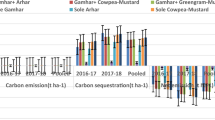Abstract
A field experiment was undertaken to identify profitable land use based on productivity, net present value, biomass and carbon stocks in litchi based land uses (LBLUs) during 1995–2015 established on degraded riverbed lands of western Himalaya, India. Results of LBLUs (20 years) revealed that LCT + LH + LPG land use produced 6.10–25.27%, 5.82–14.92% and 3.45–13.62% more fruit yield, 14.61–25.22%, 10.18–16.38% and 9.10–16.62% more total biomass, 2.95–9.51%, 0.03–4.54% and 1.60–8.26% higher carbon in soil and 6.93–14.76%, 4.60–10.03% and 6.29–13.14% more total carbon stocks as compared to sole litchi land use of 1st, 2nd and 3rd phase, respectively. Similarly, 80.39% and 78.56% more NPV, 11.74% and 19.77% higher BCR with shortest payback period (5 years) were realized in LCT + LH + LPG land use for 20 and 50 years, respectively. Sensitivity analysis also revealed that changes in discount rate will not affect its performance ranking.
Similar content being viewed by others
References
Anonymous (2010) Degraded and Wastelands of India: Status and spatial distribution. ICAR, New Delhi, p 158p
Chavan BL, Rasal GB (2012) Total sequestered carbon stock of Mangifera indica. J Environ Earth Sci 2(1):37–49
Dash MC (2010) A comparison of Industrial GHG emissions and carbon sink potential of forest vegetation in Orissa, in the context of climate change. The Ecoscan 4(2&3):147–152
Ghosh A, Kumar S, Manna MC et al (2019) Long-term in situ moisture conservation in horti-pasture system improves biological health of degraded land. J Environ Manage 248:1–10. https://doi.org/10.1016/j.jenvman.2019.109339
Ghosh SN, Pal PP (2010) Effect of intercropping on plant and soil of sweet orange orchard under rainfed conditions. Ind J Hortic 67(2):185–190
IPCC (2000) Land use, land use change and forestry: a special report of IPCC. (Eds) Watson, RT and Dokken (25–51) Cambridge University Press, England
Haile SG, Nair PKR, Nair VD (2008) Carbon storage of different soil size fractions in Florida silvipastoral systems. J Environ Qual 37:1789–1799
Kimaro AA, Isaac ME, Chamshama SAO (2011) Carbon pools in tree biomass and soils under rotational woodlot systems in eastern Tanzania. Springer, Dordrecht, pp 129–143
Kumar S, Singh AK, Singh R et al (2019) Degraded land restoration ecological way through horti-pasture systems and soil moisture conservation to sustain productive economic viability. Land Degrad Dev 30:1516–1529. https://doi.org/10.1002/ldr.3340
Lal R (2002) Carbon sequestration in dry land ecosystems of West Asia and North Africa. Land Degrad Dev 13:45–59
Manna MC, Singh MV (2001) Long term effect of intercropping and bio-litter recycling on soil biological activity and fertility status of subtropical soils. Bioresour Technol 76(2):143–150
Murovhi NR, Materechera SA, Mulugeta SD (2012) Seasonal changes in litter fall and its quality from three subtropical fruit tree species at Nelspruit. S Africa Agrofor Syst 86(1):61–71
Murthy IK, Gupta M, Tomar S et al (2013) Carbon sequestration potential of Agroforestry systems in India. J Earth Sci Clim Chang. https://doi.org/10.4172/2157-7617.1000131
Nair PKR, Kumar BM, Nair VD (2009) Agroforestry as a strategy for carbon sequestration. J Plant Nutr Soil Sci 172:10–23
Niu X, Duiker SW (2006) Carbon sequestration potential by afforestation of marginal agricultural land in Midwestern U.S. Elsevier B.V. For Ecol Manage 223:415–427
Osman AN, Rabild A, Christiansen JL, Bayala J (2011) Performance of cowpea and pearl millet intercropped Parkia in agroforestry system in Burkina Faso. Afr J Agric Res 6(4):882–891
Quin FM (1997) Advances in Cowpea Research. Sayce Publishing, Devon
Rathore AC, Raizada A, Jayaprakash J et al (2012) Impact of chilling injury on common fruit plants in Doon Valley. Curr Sci 102(8):1107–1111
Rathore AC, Saroj PL, Lal H et al (2013) Performance of mango based models under rainfed situation in NW Himalaya. Agrofor Syst 87:1389–1404
Rathore AC, Kumar A, Tomar JMS et al (2018) Predictive models for biomass and carbon stock estimation in Psidium guajava on bouldery riverbed lands in North Western Himalayas. India Agrofor Syst 92(1):171–182
Selvaraj A, Jayachandran S, Thirunavukkarasu PD et al (2016) Carbon sequestration potential, physicochemical and microbiological properties of selected trees. Bio Disc 7(2):131–139
Singh J, Randhawa GS, Singh J (1988) Effect of intercropping and mulch on yield and quality of turmeric (Curcuma longa). Acta Hortic 188 A:183–186
Takimoto A, Nair PKM, Nair VD (2008) Carbon stock and sequestration potential of traditional and improved Agroforestry systems, West Africa. Agric Ecosyst Environ 125:159–166
Vishwanatham MK, Samra JS, Sharma AR (1998) Biomass production of silvi-pasture systems on gravelly lands. Bulletin (T39/D26) Director, CSWCRTI, Dehradun
Walkley AJ, Black IA (1934) Estimation of soil organic carbon by the chromic acid titration method. Soil Sci 37:29–38
Yadav RP, Bisht JK (2014) Agroforestry to combat climate change. Kheti 66:1–11
Author information
Authors and Affiliations
Corresponding author
Additional information
Publisher's Note
Springer Nature remains neutral with regard to jurisdictional claims in published maps and institutional affiliations.
Rights and permissions
About this article
Cite this article
Rathore, A.C., Mehta, H., Sharma, N.K. et al. Performance of litchi (Litchi chinensis Sonn.) based agri-horticultural land uses in rainfed condition on degraded lands in North Western Himalayas, India. Agroforest Syst 94, 2225–2236 (2020). https://doi.org/10.1007/s10457-020-00544-z
Received:
Accepted:
Published:
Issue Date:
DOI: https://doi.org/10.1007/s10457-020-00544-z




